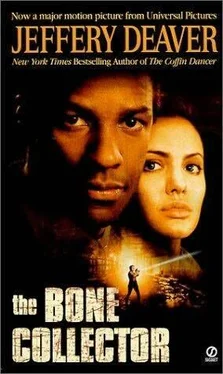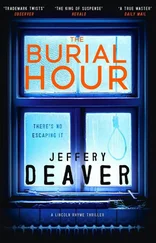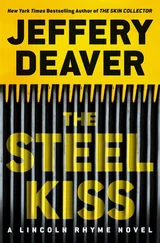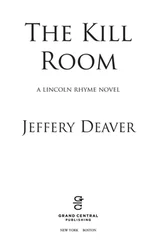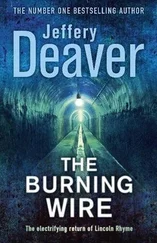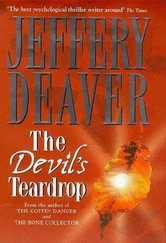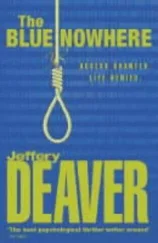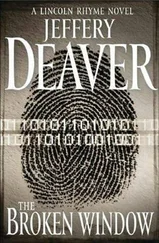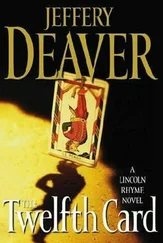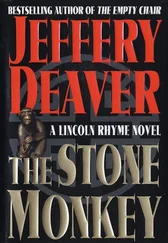Jeffery Deaver - The Bone Collector
Здесь есть возможность читать онлайн «Jeffery Deaver - The Bone Collector» весь текст электронной книги совершенно бесплатно (целиком полную версию без сокращений). В некоторых случаях можно слушать аудио, скачать через торрент в формате fb2 и присутствует краткое содержание. Жанр: Триллер, на английском языке. Описание произведения, (предисловие) а так же отзывы посетителей доступны на портале библиотеки ЛибКат.
- Название:The Bone Collector
- Автор:
- Жанр:
- Год:неизвестен
- ISBN:нет данных
- Рейтинг книги:4 / 5. Голосов: 1
-
Избранное:Добавить в избранное
- Отзывы:
-
Ваша оценка:
- 80
- 1
- 2
- 3
- 4
- 5
The Bone Collector: краткое содержание, описание и аннотация
Предлагаем к чтению аннотацию, описание, краткое содержание или предисловие (зависит от того, что написал сам автор книги «The Bone Collector»). Если вы не нашли необходимую информацию о книге — напишите в комментариях, мы постараемся отыскать её.
The Bone Collector — читать онлайн бесплатно полную книгу (весь текст) целиком
Ниже представлен текст книги, разбитый по страницам. Система сохранения места последней прочитанной страницы, позволяет с удобством читать онлайн бесплатно книгу «The Bone Collector», без необходимости каждый раз заново искать на чём Вы остановились. Поставьте закладку, и сможете в любой момент перейти на страницу, на которой закончили чтение.
Интервал:
Закладка:
“A book of matches,” she said.
“Okay, maybe he’s thinking arson. Anything printed on them?”
“Nope. But there’s a smear of something. Like Vaseline. Only stinky.”
“Good, Sachs – always smell evidence you’re not sure about. Only be more precise.”
She bent close. “Yuck.”
“That’s not precise.”
“Sulfur maybe.”
“Could be nitrate-based. Explosive. Tovex. Is it blue?”
“No, it’s milky clear.”
“Even if it could go bang I imagine it’s a secondary explosive. They’re the stable ones. Anything else?”
“Another scrap of paper. Something on it.”
“What, Sachs? His name, his address, e-mail handle?”
“Looks like it’s from a magazine. I can see a small black-and-white photo. Looks like part of a building but you can’t see which one. And underneath that, all you can read is a date. May 20, 1906.”
“Five, twenty, oh-six. I wonder if it’s a code. Or an address. I’ll have to think about it. Anything else?”
“Nope.”
She heard him sigh. “All right, come on back, Sachs. What time is it? My God, almost one a.m. I haven’t been up this late in years. Come on back and let’s see what we have.”
Of all the neighborhoods in Manhattan, the Lower East Side has remained the most unchanged over the course of the city’s history.
Much of it’s gone of course: The rolling pastoral fields. The solid mansions of John Hancock and early government luminaries. Der Kolek, the large freshwater lake (its Dutch name eventually corrupted to “The Collect,” which more accurately described the grossly polluted pond). The notorious Five Points neighborhood – in the early 1800s the most dangerous square mile on earth – where a single tenement, like the decrepit Gates of Hell, might be the site of two or three hundred murders every year.
But thousands of the old buildings remained – tenements from the nineteenth century and Colonial frame houses and Federal brick townhomes from the prior one, Baroque meeting halls, several of the Egyptian-style public buildings constructed by order of the regally corrupt Congressman Fernando Wood. Some were abandoned, their facades overgrown with weeds and floors cracked by persistent saplings. But many were still in use; this had been the land of Tammany Hall iniquity, of pushcarts and sweat-shops, of the Henry Street Settlement house, Minsky’s burlesque and the notorious Yiddish Gomorra – the Jewish Mafia. A neighborhood that gives birth to institutions like these does not die easily.
It was toward this neighborhood that the bone collector now piloted the taxi containing the thin woman and her young daughter.
Observing that the constabulary was on to him, James Schneider went once again to ground like the serpent that he was, seeking accommodations – it is speculated – in the cellars of the city’s many tenant-houses (which the reader may perchance recognize as the still-prevalent “tenements”). And so he remained, quiescent for some months.
As he drove home, the bone collector saw around him not the Manhattan of the 1990s – the Korean delis, the dank bagel shops, the X-rated-video stores, the empty clothing boutiques – but a dreamy world of bowler-clad men, women in rustling crinoline, hems and cuffs filthy with street refuse. Hordes of buggies and wagons, the air filled with the sometimes pleasant, sometimes repulsive scent of methane.
But such was the foul, indefatigable drive within him to start his collection anew that he was soon forced from his lair to waylay yet another good citizen; – this, a young man newly arrived in town to attend university.
Driving through the notorious Eighteenth Ward, once the home of nearly fifty thousand people crammed into a thousand decrepit tenements. When most people thought of the nineteenth century they thought in sepia – because of old photographs. But this was wrong. Old Manhattan was the color of stone. With choking industrial smoke, paint prohibitively expensive and dim lighting, the city was many shades of gray and yellow.
Schneider snuck up behind the fellow and was about to strike when Fortune’s conscience, at last, cried out. Two constables chanced upon the assault. They recognized Schneider and gave chase. The killer fled east, across that engineering marvel, the Manhattan Bridge, completed In 1909, two years before these events. But he stopped halfway across, seeing that three constables were approaching from Brooklyn, having heard the alarm raised by the whistles and pistol reports of their confederates from Manhattan.
Schneider, unarmed, as chance would have it, climbed onto the railing of the bridge as he was surrounded by the law. He shouted maniacal diatribes against the constables, condemning them for having ruined his life. His words grew ever madder. As the constabulary moved closer, he leapt from the rail into the River. A week later a pilot discovered his body on the shore of Welfare Island, near Hell Gale. There was little left, for the crabs and turtles had been diligently working to reduce Schneider to the very bone which he, in his madness, cherished.
He turned the taxi onto his deserted cobblestoned street, East Van Brevoort, and paused in front of the building. He checked the two filthy strings he’d run low across the doors to make certain that no one had entered. A sudden motion startled him and he heard the guttural snarling of the dogs again, their eyes yellow, teeth brown, bodies dotted with scars and sores. His hand strayed to his pistol but they suddenly turned and, yelping, charged after a cat or rat in the alley.
He saw no one on the hot sidewalks and opened the padlock securing the carriage-house door then climbed back inside the car and drove into the garage, parked beside his Taurus.
After the villain’s death his effects were secured and perused by detectives. His diary showed that he had murdered eight good citizens of the city. Nor was he above grave robbery, for it was ascertained from his pages (if his claims be true) that he had violated several holy resting places In cemeteries around the city. None of his victims had accorded him the least affront; – nay, most were upstanding citizens, industrious and innocent. And yet he felt not a modicum of guilt. Indeed, he seems to have labored under the mad delusion that he was doing his victims a favor.
He paused, wiped sweat from his mouth. The ski mask itched. He dragged the woman and her daughter out of the trunk and through the garage. She was strong and fought hard. At last he managed to get the cuffs on them.
“You prick!” she howled. “Don’t you dare touch my daughter. You touch her and I’ll kill you.”
He gripped her hard around the chest and taped her mouth. Then he did the little girl’s too.
“Flesh withers and can be weak,” – (the villain wrote in his ruthless yet steady hand) – “Bone is the strongest aspect of the body. As old as we may be in the flesh, we are always young in the bone. It is a noble goal I had, and it is beyond me why any-one might quarrel with it. I did a kindness to them all. They are immortal now. I freed them. I took them down to the bone.”
He dragged them into the basement and pushed the woman down hard on the floor, her daughter beside her. Tied their cuffs to the wall with clothesline. Then returned upstairs.
He lifted her yellow knapsack from the back of the cab, the suitcases from the trunk, and pushed through a bolt-studded wooden door into the main room of the building. He was about to toss them into a corner but found that, for some reason, he was curious about these particular captives. He sat down in front of one of the murals – a painting of a butcher, placidly holding a knife in one hand, a slab of beef in the other.
Читать дальшеИнтервал:
Закладка:
Похожие книги на «The Bone Collector»
Представляем Вашему вниманию похожие книги на «The Bone Collector» списком для выбора. Мы отобрали схожую по названию и смыслу литературу в надежде предоставить читателям больше вариантов отыскать новые, интересные, ещё непрочитанные произведения.
Обсуждение, отзывы о книге «The Bone Collector» и просто собственные мнения читателей. Оставьте ваши комментарии, напишите, что Вы думаете о произведении, его смысле или главных героях. Укажите что конкретно понравилось, а что нет, и почему Вы так считаете.
